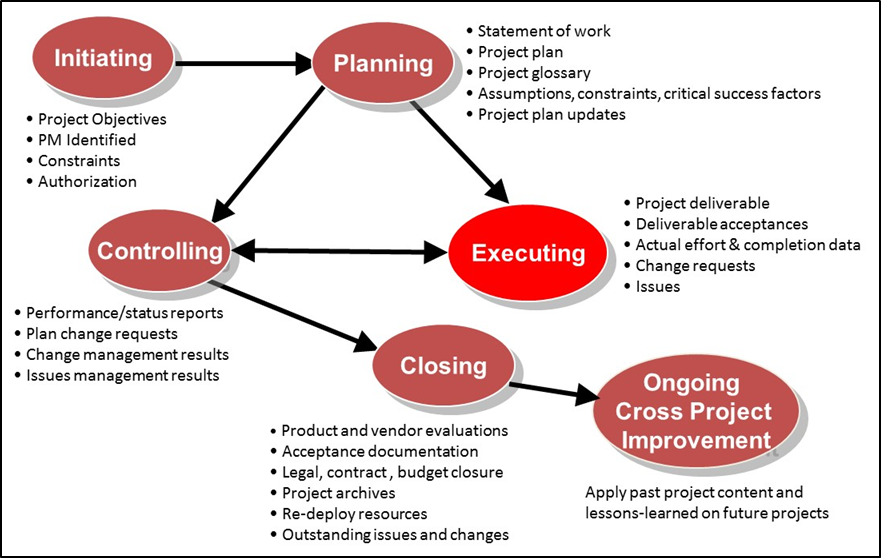Project Management Process Groups
Describing a project by its life cycle is a useful analogy, but it lacks important detail. Namely, it doesn't describe the processes necessary to move from one phase to another. We will group these processes into five categories, all of which can and should occur in each phase of a project's life. These processes, as defined by the PMI and illustrated in Figure 2-1 are:
- Initiating
- Planning
- Executing
- Controlling
- Closing
Initiating processes are actions that begin a phase of a project. For example, most organizations will not begin work on a project for another organization until a formal contract is signed. In this case, moving from the development phase to the implementation phase is dependent on an initiating process. Planning processes ensure projects align with an organization's mission. For example, an organization may plan an outcome assessment at the close-out phase of a project. Executing processes coordinate people, resources, and activities to accomplish work (following tasks in the project plan and completing project deliverables). This Executing process group is the place where work actually gets done—all of the other process groups support project execution activities. Controlling processes are designed to ensure project success. An extension of a deadline at no cost to the client would be an example of a controlling process. Finally, Closing processes end a phase or project. Creating an archive of a GIS project is an example of a closing process. In addition, the PMI suggests documenting "lessons learned" to serve as a project knowledge base for future projects. A "Lessons Learned" knowledge base is a summary of work, practices, and methods compiled from past projects or external sources that worked well or should be avoided.

Click for a text description of figure 2-1: Project management process elements
Figure 2-1 explains “project management process elements” as defined by the Project Management Institute (PMI). It shows each of the six process elements as shaded oval shapes, with connecting arrows showing the relationships among the process elements. Each of the process element oval shapes has a text list of the main activities and products for the Process Element. These PMI "process groups" are NOT meant to be used as project phases in a project work plan. They provide a perspective on activities and concerns that need to be addressed by the organization and a project manager before the project starts, during its execution, and after it is closed.
The Initiating process element, shown at the top left of the figure, contains processes such as identifying project objectives, PM, constraints, and authorizations. Initiating leads to planning, where you would identify the statement of work, project plan, project glossary, assumptions, constraints, critical success factors, and project plan updates. The Initiating process element shape has a single arrow connecting to the right with the Planning process element shape. The Planning process element lists the items: Statement of work, Project Plan, Project glossary, Assumptions, constraints and critical success factors, and Project plan updates. The Planning process element has a forked path to the Controlling process element includes the items, performance management and status reports, plan change requests, change management results, and issue management results. The Controlling process element has a double arrow line connecting to the Executing process element to the right and a single arrow connecting it to the Closing process element down and to the right. The Executing process element includes work on project deliverables, deliverable acceptance, actual effort and complete data, change requests, and project issue compilation. The Closing process element includes final product and vendor evaluations, acceptance documentation, legal closures, project archives, re-deploy resources, and outstanding issues and changes. The final phase is Ongoing Cross Project Improvement shown as an oval shape in the bottom right of the figure with a connecting line from the Closing process element. This Closing process element has the text, Apply past project content and compile lessons-learned on future projects.